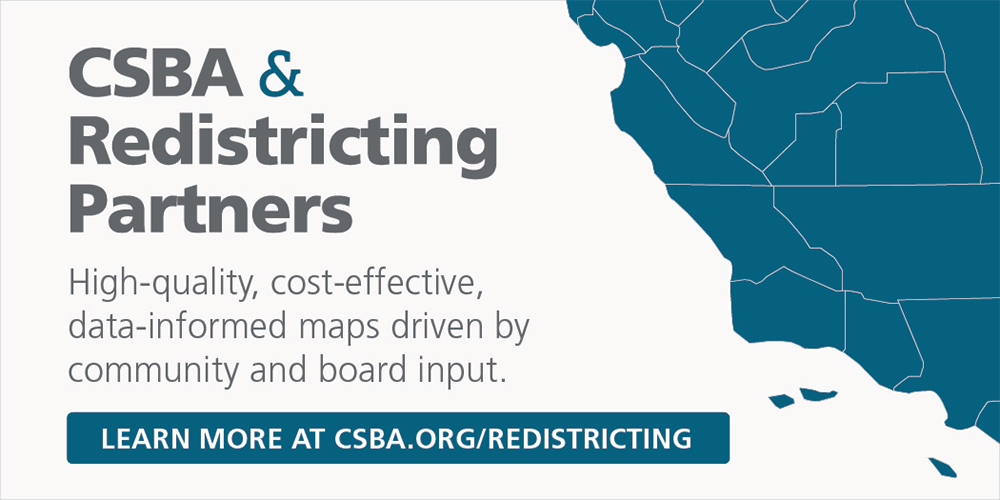Governance
Resources


The goal of the first meeting was to collect the perspective of small districts on the implementation of Senate Bill 328 — known as the late start bill — and what effects it has had for districts, students and families. In an effort to address sleep deprivation among students, the bill also created significant challenges for districts related to transportation, staffing, bell schedules, extracurriculars and more.
While some participants expressed that, for the most part, their district had not been impacted, that wasn’t a common refrain among those in attendance.

Troy Flint | tflint@csba.org
Editorial Director:
Kimberly Sellery | ksellery@csba.org
Staff Writers and Contributors:
Alisha Kirby | akirby@csba.org
Heather Kemp | hkemp@csba.org
Teresa Machado | tmachado@csba.org
Dana Scott | dscott@csba.org
Sally Mandujan | smandujan@csba.org
Director of Graphic Design & Branding:
Kerry Macklin | kmacklin@csba.org
Senior Graphic Designer:
Amanda Moen | amoen@csba.org
Susan Markarian | Pacific Union ESD
President-elect:
Albert Gonzalez | Santa Clara USD
Vice President:
Bettye Lusk | Monterey Peninsula USD
Immediate Past President:
Dr. Susan Heredia | Natomas USD
CEO & Executive Director:
Vernon M. Billy
California School News (ISSN 1091-1715) is published 11 times per year by the California School Boards Association, Inc., 3251 Beacon Blvd., West Sacramento, CA 95691. 916-371-4691. $4 of CSBA annual membership dues is for the subscription to California School News. The subscription rate for each CSBA nonmember is $35. Periodicals postage paid at West Sacramento, CA and at additional mailing office. POSTMASTER: Send address changes to California School News, 3251 Beacon Blvd., West Sacramento, CA 95691.
News and feature items submitted for publication are edited for style and space as necessary.

At an Aug. 14 press conference hosted by the California Department of Education, CSBA joined the Association of California School Administrators, California Teachers Association and California Federation of Teachers to shed light on the teacher shortage crisis and advocate for solutions. As a 38-year school board member in the Pacific Union Elementary School District, I’ve seen firsthand the difference teachers make and how challenging it can be to recruit and retain effective teachers, especially in areas likes mine in rural Fresno County. The teacher shortage is typically illustrated through media stories focusing on large urban and suburban districts, but it’s even more profound in many of our small, rural school districts and more remote county offices of education. This is the type of equity issue that too often goes unseen and unheard, but it has profound impact on academic achievement and life outcomes for the youth in rural communities and elsewhere.

Schools are encouraged to partner with local county elections officials “to promote civic education and participation on campus and foster an environment that cultivates lifelong voters and active citizens,” according to the Secretary of State’s website.
As high schoolers return from summer break and refocus on academics and planning for life post-graduation, the department has a Back-to-School Pre-Registration Toolkit (bit.ly/3OxBFjv) available to encourage eligible 16- and 17-year-olds to pre-register online to vote, with their registration becoming active upon turning 18. It is a task that can easily be added to their back-to-school checklist.
Board of education trustees occasionally comment — sometimes in frustration, sometimes with humor — about the ever-present “alphabet soup” that governance teams must acquaint themselves with. Education acronyms are regularly used to identify programs impacting the approximately 6 million students that California local educational agencies serve.
Some acronyms are well known, such as LCAP (Local Control and Accountability Plan), CDE (California Department of Education), LEA (local educational agency) and ADA (average daily attendance).

Schools play a critical role in preparing these students for success in college, career and civic life. Often, a great place to start addressing student needs is by first bolstering family engagement, according to Andrew Ferson, director of Policy for the Parent Institute for Quality Education (PIQE).
Research has long shown that strong family engagement practices can boost graduation and establish a college going culture, improve grades and achievement in both English and math, increase rates of completion of the courses required for university admission and more.
5 Questions with Peter Noymer, Los Gatos Union SD

We’re also in the early days of using a data management system that is showing promise in its ability to clearly highlight successes and provide early warnings where interventions are needed. Wrapping around all that, we have been holding regular board study sessions, roughly three to four per year, to dive into these topics with the district leadership team to make sure that new programs are designed to meet the needs of our community. In addition, our district put in place a three-year salary agreement with our teacher’s union, when one-year agreements had been the norm, and that has helped set a solid foundation for success in all of our efforts. Our goal with the agreement was to better align salaries with comparable school districts, and having a multi-year agreement helps with teacher morale and supports our staff’s significant efforts in literacy, STEAM and project-based learning.

On July 10, Gov. Gavin Newsom signed the Education Omnibus Trailer Bill, Senate Bill 114, which revised the language of Education Code section 47605 regarding appeals to the State Board of Education (SBE) of charter school petitions denied by school districts and county boards of education.
Specifically, the bill contains revisions that clarify the standard for SBE’s consideration of appeals of denied charter school petitions. The revisions mirror arguments CSBA’s Education Legal Alliance (ELA) made in the litigation it initiated against SBE regarding its grant of an appeal to the Mayacamas Charter School in the Napa Valley Unified School District. (The district also filed a legal action against the SBE.) As discussed in a July 3 CSBA blog post (bit.ly/3P8J2Oz), the ELA filed a writ of mandate in January, seeking to invalidate the SBE’s decision on the Mayacamas Charter School’s petition appeal, and argued that SBE used the incorrect standard of review and substituted its own judgment for that of the local boards, rather than the “abuse of discretion” standard as required by law.

A variety of resources and strategies available to assist local educational agencies in their attempts to curb chronic absenteeism were discussed during the Aug. 9 webinar, “A Healthy Return to School: Ensuring Showing Up,” hosted by Attendance Works and the Institute for Educational Leadership.
Just ahead of Attendance Awareness Month in September, presenters detailed the attendance crisis plaguing K-12 classrooms across America. Prior to the pandemic, roughly one out of every six students was considered chronically absent — having missed 10 percent or more of school days regardless of whether the absence was excused, unexcused or due to a suspension. At the conclusion of the 2021–22 academic year, more than one in four students was affected in multiple states, with low-income, Native American, Black and Pacific Islander students disproportionately impacted.
Assembly Bill 101 requires that all LEAs begin offering an ethnic studies course by the 2025–26 school year and establishes its place as a graduation requirement beginning in 2029–30.
The ESMC focuses on the four traditional pillars of ethnic studies — African American, Latino/Chicano, Native American and Asian American/Pacific Islander studies — and CDE staff emphasized there is also intersection with many other identities in the model curriculum.

Each school year presents a unique set of challenges to prepare students for future success. This year, machine learning, or artificial intelligence (AI) as it is more commonly known, has become a prioritized area of focus for educators at every level of the school system — and for good reason. In a world where nearly every aspect of communal life is driven by data and technology, educators are recognizing the transformative potential of AI to address many longstanding challenges within education systems.
One such enthusiastic educator is Sal Khan, founder and CEO of Khan Academy, an online tutoring platform that has been widely used and promoted in classrooms around the world for nearly two decades. In a recent TED Talk, Khan explained why the nonprofit made the choice to use generative AI technology to enhance the user experience for both teachers and students.

Family disruptions, trauma, out-of-home placements and school changes are common experiences among children in foster care, and often result in higher rates of disciplinary problems, grade repetition, special education placement and dropping out of high school, as well as lower academic achievement, and increased barriers to postsecondary education.
However, for the more than 52,000 youth in California’s foster care system, school stability, positive relationships with peers, positive school experiences and strong connections with adult mentors have all been linked to improved educational outcomes among students with foster care experience (FCE).
To implement strategies known to benefit students in foster care, local educational agencies can look to Sweetwater Union High School District’s (SUHSD) practices, programs and policies that promote the academic well-being of students with FCE as an example of what can happen when students receive the support they need to succeed, according to a new brief.
LCFF was implemented 10 years ago and brought a fundamental shift to the way California schools are funded. It increased funding for high-need students (low-income, English learner and foster youth) with a weighted formula. PPIC Research Fellow Julien Lafortune explained that each district gets roughly $10,000 per student. For each additional high-need student, a supplemental grant provides 20 percent more per pupil and if a district has 55 percent or more high-need students, concentration grant funding kicks in with an additional 50 percent of the base rate per student for each student above threshold. It is important to note that this is an unduplicated pupil count, meaning that each student is counted only once, even if they fall into multiple high-need categories.
“Prior to LCFF, when we count total spending — which includes the funding formula, revenues and also funding from federal and other sources —it was about $14,00 per student in 2012–13 and most recently it’s close to $23,000 per student,” Lafortune said, while acknowledging that some of that funding is one-time COVID relief aid.

Schools can play an integral role in suicide prevention, and can equip students with the coping skills, support and resources that stay with them even after graduation. The Orange County Department of Education — which leads the statewide implementation of California’s Multi-Tiered System of Support framework — has partnered with the Orange County Health Care Agency, Children’s Hospital of Orange County (CHOC), Western Youth Services and CalOptima Health to develop a plan to increase services and support for student mental health in all of Orange County’s 28 school districts.
The Brown Act
Equity Network Training
Oct. 2–30 (4 sessions)
MIG Course 1: Foundations of Effective Governance/Setting Direction
Sept. 27 | North Bay
Oct. 2 | East Bay
Oct. 4 | Calaveras County
Oct. 4 | Lake County
Oct. 11 | Santa Cruz County
Oct. 17 | Fresno County
Oct. 23 | Kern County/Bakersfield
Oct. 23 | San Mateo County
Oct. 25 | Shasta/Siskiyou counties
MIG Course 3: School Finance Parts 1 & 2 | San Marcos
MIG Course 2: Student Learning & Achievement/Policy & Judicial Review | Sunnyvale










